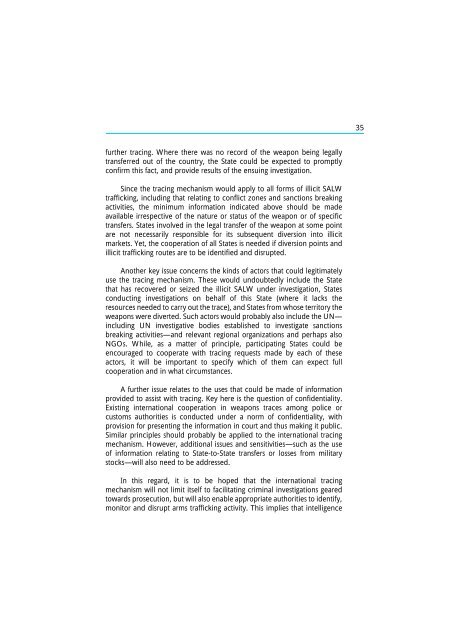The Scope and Implications of a Tracing Mechanism for Small Arms ...
The Scope and Implications of a Tracing Mechanism for Small Arms ...
The Scope and Implications of a Tracing Mechanism for Small Arms ...
You also want an ePaper? Increase the reach of your titles
YUMPU automatically turns print PDFs into web optimized ePapers that Google loves.
35<br />
further tracing. Where there was no record <strong>of</strong> the weapon being legally<br />
transferred out <strong>of</strong> the country, the State could be expected to promptly<br />
confirm this fact, <strong>and</strong> provide results <strong>of</strong> the ensuing investigation.<br />
Since the tracing mechanism would apply to all <strong>for</strong>ms <strong>of</strong> illicit SALW<br />
trafficking, including that relating to conflict zones <strong>and</strong> sanctions breaking<br />
activities, the minimum in<strong>for</strong>mation indicated above should be made<br />
available irrespective <strong>of</strong> the nature or status <strong>of</strong> the weapon or <strong>of</strong> specific<br />
transfers. States involved in the legal transfer <strong>of</strong> the weapon at some point<br />
are not necessarily responsible <strong>for</strong> its subsequent diversion into illicit<br />
markets. Yet, the cooperation <strong>of</strong> all States is needed if diversion points <strong>and</strong><br />
illicit trafficking routes are to be identified <strong>and</strong> disrupted.<br />
Another key issue concerns the kinds <strong>of</strong> actors that could legitimately<br />
use the tracing mechanism. <strong>The</strong>se would undoubtedly include the State<br />
that has recovered or seized the illicit SALW under investigation, States<br />
conducting investigations on behalf <strong>of</strong> this State (where it lacks the<br />
resources needed to carry out the trace), <strong>and</strong> States from whose territory the<br />
weapons were diverted. Such actors would probably also include the UN—<br />
including UN investigative bodies established to investigate sanctions<br />
breaking activities—<strong>and</strong> relevant regional organizations <strong>and</strong> perhaps also<br />
NGOs. While, as a matter <strong>of</strong> principle, participating States could be<br />
encouraged to cooperate with tracing requests made by each <strong>of</strong> these<br />
actors, it will be important to specify which <strong>of</strong> them can expect full<br />
cooperation <strong>and</strong> in what circumstances.<br />
A further issue relates to the uses that could be made <strong>of</strong> in<strong>for</strong>mation<br />
provided to assist with tracing. Key here is the question <strong>of</strong> confidentiality.<br />
Existing international cooperation in weapons traces among police or<br />
customs authorities is conducted under a norm <strong>of</strong> confidentiality, with<br />
provision <strong>for</strong> presenting the in<strong>for</strong>mation in court <strong>and</strong> thus making it public.<br />
Similar principles should probably be applied to the international tracing<br />
mechanism. However, additional issues <strong>and</strong> sensitivities—such as the use<br />
<strong>of</strong> in<strong>for</strong>mation relating to State-to-State transfers or losses from military<br />
stocks—will also need to be addressed.<br />
In this regard, it is to be hoped that the international tracing<br />
mechanism will not limit itself to facilitating criminal investigations geared<br />
towards prosecution, but will also enable appropriate authorities to identify,<br />
monitor <strong>and</strong> disrupt arms trafficking activity. This implies that intelligence
















